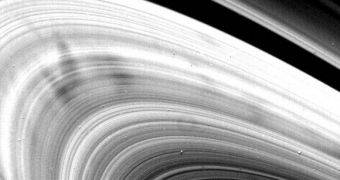The Cassini-Huygens space probe is arguably one of the most important missions NASA ever sent out into the solar system, in terms of return benefits and information accuracy. The craft has thus far managed to discover new moons around Saturn, and to offer invaluable scientific data on interesting natural satellites such as Enceladus and Titan. Now, the spacecraft leads the way in the search for possible life on the planet, with its investigations on the mysterious gas and ice plumes that Enceladus is spewing into its atmosphere from its poles.
According to readings taken by Cassini, it may be that an entire Saturnine ring is made of salts emitted by the small moon. Enceladus is located at the very core of the planet's E Ring, in an area where the dust or ice density is the largest.
Theories have proposed that, on account of the fact that the ring is so large (nearly 1,000,000 kilometers wide), it may be that something is replenishing the amount of dust or ice in it. When astronomers first proposed the idea that matter coming from Enceladus was adding to the ring, most members of the scientific community regarded it as ridiculous.
Now, it would seem that data received from the NASA probe, which was launched on October 15th, 1997, supports the earlier hypothesis. Since it arrived in Saturn's orbit, on July 1st, 2004, the craft has been transmitting data about the planet and its satellites virtually non-stop. Until now, it had about 18 encounters with Enceladus alone, with an additional four more planned to take place until the end of 2010, when the spacecraft's mission is scheduled to be terminated. However, chances are that the probe will not be abandoned, and that funding will continue for years to come.
“Salty grains provide our current best smoking (or steaming) gun pointing to present-day liquid water near the surface of Enceladus,” Southwest Research Institute Space Scientist John Spencer explained. In an essay, the expert wrote that recent Cassini measurements revealed the existence of sodium salts in the satellite's emissions, which means that the small celestial body could very well be harboring a liquid water ocean. “Our picture of its subsurface must now be expanded to include the possibility of misty ice caverns floored with pools and channels of salty water. What else may lurk in those salty pools, if they exist, remains to be seen.”
“We proposed that the crust of Enceladus was composed of two layers: One, a surface layer of ice with carbon dioxide, and two, starting at no more than 3 kilometers, a mixture of icy clathrates that overlaid the core. Gas is released from the clathrates by the earthquakes associated with the tectonic activity at the south pole. In that way, we were able to account quantitatively for the gases observed in the plume,” University of Illinois Scientist Susan Kieffer added, quoted by Wired.

 14 DAY TRIAL //
14 DAY TRIAL //